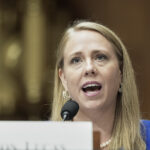Gov. James Douglas has rolled out the 2006 model of his health care plan: Gone is the tax on insurance premiums that hampered sales of the 2005 model. And the new model is streamlined, focusing much of its attention on the roughly one-third of uninsured Vermonters who simply can’t afford to buy insurance.
“I want every Vermonter to have a primary care physician, someone who coordinates his or her care. I really believe the basic reason, the most common reason, most people don’t is they can’t afford it,” said Douglas.
The governor’s proposal divides the roughly 60,000 uninsured Vermonters into three categories and calls for different strategies for each group:
For the 45 percent of the uninsured who are potentially eligible for Medicaid, an effort would be made to enroll them into the program;
For the 34 percent who do not qualify for Medicaid but have low or moderate incomes the state will provide financial help to buy insurance;
For the 21 percent with incomes greater than 300 percent of the federal poverty level, efforts will be made to get them insurance but without any financial aid.
A key to the Douglas plan is creation of a basic insurance policy that will be offered to those who now lack insurance. The policy will be low cost because the people enrolled in the program will be rated separately from other Vermonters.
Douglas’ new plan also includes other provisions, like an increase in the amount the state would pay doctors for providing Medicaid services and an effort to allow Vermonters to buy insurance from out of state providers, but the primary focus is on the uninsured.
The state’s emphasis would be on providing assistance to the roughly 21,000 uninsured Vermonters who can’t afford it. The state would define those as household incomes between one and a half times to three times the federal poverty level of $9,570 for a person living alone or $19,350 for a family of four.
The Douglas program would help pay for the cost of the insurance for those households.
Douglas and the Democratic leaders in the Legislature have reached an agreement that they will separate health care into different components in the upcoming session.
First will be consideration of a package of items on which there is broad agreement, such as improving medical information technology, giving medical professionals the ability to acknowledge errors without facing liability and giving insurance discounts for healthy lifestyles. The governor would also like to include expansion of a chronic care initiative in this first package but legislative leaders suggest there may be enough differences on that issue to make that unlikely.
The second package is expected to focus on the uninsured.
Democratic leaders have been promoting a broader effort than the governor; they want companies and individuals who do not now have health care to contribute toward the cost. Democrats opposed Douglas’ earlier reliance on the insurance premium tax as a financing mechanism; the governor said he was able to drop that provision because his new proposal is focused more specifically, has a basic insurance plan that will cost less, and because state taxes are generating enough of a surplus to finance the expansion.
Sen. Peter Welch, D-Windsor, the president pro tem of the Senate, said Democrats would review the governor’s plan when the details become available but that generally he felt it did not do enough.
“We think there are two problems, the overall cost of health care and the number of folks who are uninsured,” he said. “We want to do more to bring down the cost of health care for everyone.”
Paul Harrington of the Vermont Medical Society praised the governor for “his focus on providing more affordable health care to all Vermonters.”
“I think his strategy of tailored solutions to different populations is the right one,” he said.
Was this article valuable?
Here are more articles you may enjoy.


 Louvre Tightens Security After $102M Jewel Heist, Installs Bars on Infamous Window
Louvre Tightens Security After $102M Jewel Heist, Installs Bars on Infamous Window  Grand Jury Declines to Indict Man in Fatal Shooting at Kentucky State University
Grand Jury Declines to Indict Man in Fatal Shooting at Kentucky State University  Head of EEOC Urges White Men to Report Discrimination
Head of EEOC Urges White Men to Report Discrimination  Fire Damages Portland, Maine’s Historic Waterfront
Fire Damages Portland, Maine’s Historic Waterfront 

